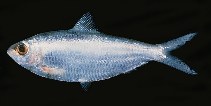| Family: |
Dorosomatidae (Gizzard shads and sardinellas) |
| Max. size: |
15 cm TL (male/unsexed); max.weight: 35.6 g |
| Environment: |
pelagic-neritic; brackish; marine; depth range 0 - 50 m |
| Distribution: |
Indo-West Pacific: Red Sea, Persian Gulf, East African coasts, Madagascar eastward to Indonesia and the Arafura Sea (Ref. 9819), north to Taiwan and south to Papua New Guinea (Ref. 188). |
| Diagnosis: |
Dorsal spines (total): 0-0; Dorsal soft rays (total): 18-20; Anal spines: 0-0; Anal soft rays: 21-23. This species is distinguished by the following characters: body highly compressed, its depth 28.8-33.8% of standard length; interrupted longitudinal striae formation in lateral scales; prepelvic and post-pelvic scutes count 18 + 12-13 (usually 18+12); A 21-23 rays (usually 22); gill rakers 47–64 (Ref. 114969).
Description: total number of scutes 29-33; vertical striae on scales not meeting at centre, hind part of scale with a few perforations and somewhat produced posteriorly; a dark spot at dorsal fin origin (Ref. 188). It closely resembles Sardinella fimbriata and S. dayi, which have more lower gill rakers, 54-82 in S. fimbriata and 88-126 in S. dayi; and can be confused with S. gibbosa and S. sindensis, which have more scutes, 31-34; other similar species have more scutes or more gillrakers or overlapping scale striae or no spot at dorsal fin origin or caudal tips black, or a combination of some of these features (Ref. 122366); belly with sharp keel of scutes (Ref. 188, 3259); more than 8 fronto-parietal striae (Ref. 2871, 9391); dorsal fin with 4 unbranched and 14-16 branched rays; pectoral fin with 1 unbranched and 13-16 branched rays; pelvic fin with 1 unbranched and 7 branched rays (Ref. 3259). Lateral line scales 40-45; predorsal scales paired and overlapping (Ref. 2871, 3259). Total number of scutes 29-33; with 17-19 pre-pelvic scutes and 11-15 post-pelvic scutes (Ref. 188, 3259).
Colouration: Back blue-green; flanks silver; hind margin of caudal fin dusky (Ref. 3259). A small dark spot at dorsal fin origin (Ref. 188, 2871, 9391). |
| Biology: |
Found in coastal waters (Ref. 30573). Forms schools. Feeds on zooplankton and phytoplankton (Ref. 30573). Marketed fresh, dried, dried-salted, and made into fish balls. |
| IUCN Red List Status: |
Least Concern (LC); Date assessed: 28 February 2017 Ref. (130435)
|
| Threat to humans: |
harmless |
Source and more info: www.fishbase.org. For personal, classroom, and other internal use only. Not for publication.

